ENEA Microbial Culture Collection

Biorestoration: Microbial Biotechnologies for Cultural Heritage
Microbial biotechnologies have strong innovative potential for the development of a more sustainable restoration strategy (Biorestauration). Microbially derived products can replace toxic substances in use, are selective towards the deposits to be removed, respectful of the original material, and harmless to operators. They are based on the use of live microbial cells, mainly bacteria, of environmental origin, non-pathogenic, and non-genetically modified, making them safe and without usage restrictions. The bacteria are immobilized within an inert support chosen according to the specific case ("micro-packs"). They are easy to use as they do not require stringent operational conditions. Biorestoration finds applications for cleaning and consolidation issues.
Bio-cleaning
Thanks to their specific metabolic characteristics, strains from the collection have found application in the Cultural Heritage sector and are currently used for bio-restoration interventions. Since 2013, these applications have involved numerous works of art by important artists such as Carracci, Algardi, Balzico, Michelangelo, Sansovino, demonstrating their feasibility in the field. The application in the field of Cultural Heritage has led to the European patent ENEA EP 3046779 B1, of which three strains from the collection, deposited at the DSMZ collection, are an integral part. In recent years, the collection has been enriched with strains from archaeological sites, monuments, and art works. A wide range of "demonstration cases," conducted in restoration sites on various types of artifacts with different issues, has provided evidence of the actual potential of microbial biotechnologies in the field of Cultural Heritage.
Bio-consolidation
Bacteria produce a variety of crystals, including calcite. Bacterial biomineralization is a widespread phenomenon in nature, and most limestone rocks have a biological origin and the biocalcite is a material more compatible than synthetic consolidants. This capability can be used in the conservation of cultural heritage for the bio-consolidation of monuments and stone works.


